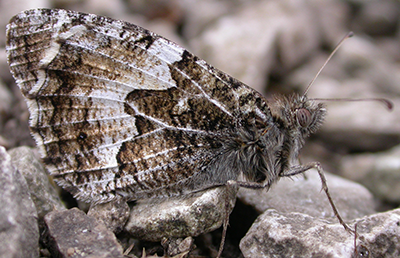Two declining butterflies suffered their lowest numbers in a 42-year series last year after hopes of a butterfly revival in the UK were dashed by a chilly snap in spring and a gloomy, wet summer. The latest UK Butterfly Monitoring Scheme (UKBMS) report for 2017 revealed that the Grayling and Grizzled Skipper both suffered their worst year since the records began, as difficult weather conditions caused problems for some of the UK’s species.

Although butterfly numbers last year were up on 2016, they were still way below average, with 2017 being the seventh worst year in the UKBMS record.
Grizzled Skipper and Grayling (pictured) in fact had their worst year on record for the second year running. Grizzled Skipper was down 9% compared to 2016 and the population has now more than halved since the 1970s. Grayling declined by 6% compared to 2016; its numbers have shrunk by 63% over the last decade. The threatened Dingy Skipper saw numbers fall by 22% compared to 2016 and the rare Marsh Fritillary experienced a decline of 12% over the same period.
But it wasn’t just rare species that struggled – the Large White, one of the UK’s most well-known and widespread butterflies, saw its numbers tumble by 19%. This common butterfly is now also in a state of long-term decline.
Dr Marc Botham, Ecologist at the Centre for Ecology & Hydrology specialising in Lepidoptera, said, “The weather can have a serious impact on individual species’ numbers each year as results from counts in 2017 show.
Long-term trends
"However, populations can and do bounce back providing suitable habitat is available, and it is the long-term trends, particularly the declines of a number of common and widespread species, which are of great concern."
"...it is the long-term trends, particularly the declines of a number of common and widespread species, which are of great concern." Dr Marc Botham, Centre for Ecology & Hydrology
There had been hopes for a good butterfly year as many spring species emerged earlier than usual following a warm start to 2017. Butterflies need warm, dry weather during their flight periods in order to feed and mate. But a cold snap at the end of April saw spring species such as the Grizzled Skipper and Duke of Burgundy struggle. The second half of the summer was cloudier and wetter than average which caused further problems for species already struggling from a combination of habitat loss and climate change.
The other two common white butterflies also had a poor year. Small White was down 16% and Green-veined White down 2%. But many species did enjoy a better year than 2016.The widespread Red Admiral was up 78% compared to 2016 and Comma numbers rose by 91% compared to 2016. Both species are increasing over the long term. The warm start to the year helped some spring butterflies such as the threatened Pearl-bordered Fritillary whose numbers rose by 57% compared to 2016. This is a species that has also benefitted from targeted conservation work.
The rare White Admiral bounced back following a terrible 2016 with an annual increase of 157%. Small Copper was up 28% compared to 2016 after a series of poor years and had its best year on record in Northern Ireland.
UKBMS is led by Butterfly Conservation, the Centre for Ecology & Hydrology (CEH), British Trust for Ornithology (BTO) and Joint Nature Conservation Committee (JNCC). It has run since 1976 and involves thousands of volunteers collecting data through the summer. Last year a record 2,693 sites were monitored across the UK.
Additional information
Butterfly Conservation issued a press release about the UKBMS 2017 results
UK Butterfly Monitoring Scheme website
UK summary of changes 2017 table
Country-level summary of changes 2017 table
Staff page of Dr Marc Botham, Centre for Ecology & Hydrology
